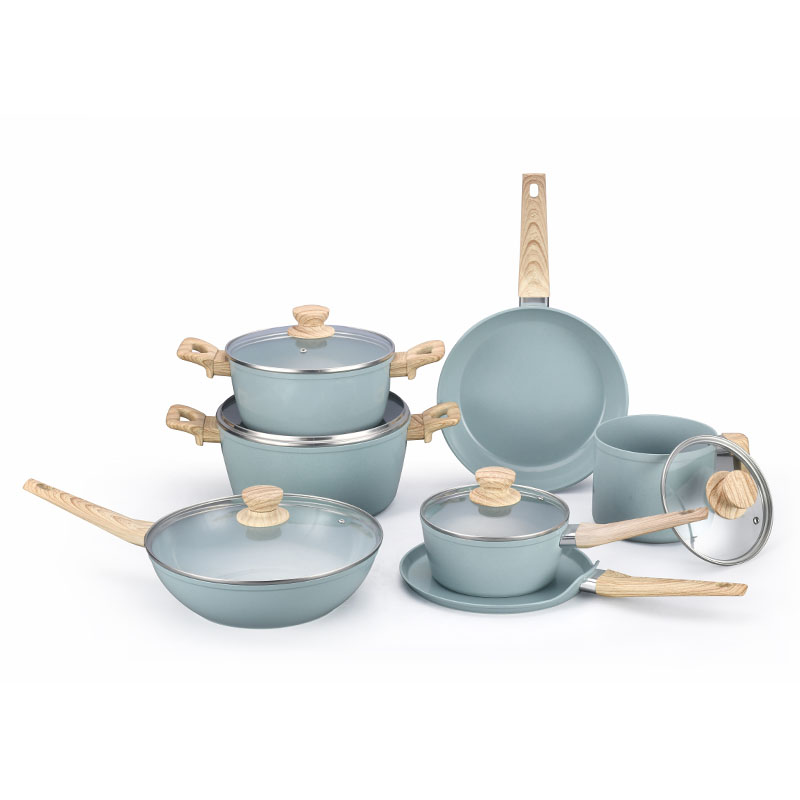
A good quality pan is undoubtedly a prerequisite for cooking delicious meals. However, many people are often confused when choosing pans. Compared with ordinary woks that require superb cooking skills, non-stick pans are favored by consumers because of their non-stick, non-stick and easy-to-clean characteristics. Currently on the market, non-stick pan coatings are mainly divided into two categories: Teflon and ceramic. With the health controversy of Teflon non-stick pans, cookware manufacturers replaced traditional non-stick materials with seemingly safer ceramic coatings.
What is ceramic-coated cookware?
Cookware coatings have been used for decades. Since the 1940s, manufacturers have been using fluoropolymer coatings such as polytetrafluoroethylene (PTFE) to make non-stick cookware. PTFE, commonly known as Teflon, is water-resistant and has a high melting point. Unfortunately, some of the chemicals used to make fluoropolymer coatings are known to be toxic.
For example, the traditional Teflon manufacturing process uses perfluorooctanoic acid (PFOA), which does not decompose in the environment like other materials. After PFOA came under scrutiny in the 1990s, cookware manufacturers stopped using the substance in nonstick pans, and ceramic-coated cookware gained popularity as a safe alternative.
But the PFOA controversy also raised larger questions for health-conscious consumers, who wondered whether cookware coatings were really as safe as industry insiders claimed.
How is ceramic-coated cookware made?
A ceramic-coated pan is essentially a metal pan covered with a thin layer of ceramic. The base, or metal core, varies from brand to brand.
As for ceramic coatings, most aren't really ceramic. They're actually "sol-gel" coatings that contain silica (sand) and other inorganic chemicals. The sol-gel process is the preferred method for spraying ceramic coatings onto cookware to make it nonstick.
While sol-gel coatings are technically tougher than PTFE coatings and can withstand higher temperatures, most companies advise customers not to heat ceramic-coated cookware above 500 degrees Fahrenheit (about 270 degrees Celsius)—any higher temperatures can cause the ceramic coating to break down. As the coating breaks down, ceramic-coated cookware loses its nonstick properties, and the surface becomes rough. For this reason, it is generally not recommended to put this cookware in the dishwasher or oven.
Lifespan of Ceramic Coatings
The smooth surface of ceramic-coated cookware will generally age over time. Regular exposure to high temperatures can accelerate this process. Well-maintained ceramic-coated cookware can be expected to last one to two years.
How to Use and Care for Your Ceramic-Coated Cookware
Properly caring for your cookware can help you extend its life, saving you money and reducing waste. What's more, taking the time to care for your ceramic-coated cookware can protect you from harmful ingredients in the coating and metal core.
Here are some practical tips for maintaining ceramic-coated cookware, which can effectively extend its life and maintain good cooking performance:
1. Avoid high-temperature dry burning
Ceramic coatings are sensitive to high temperatures. Avoid heating empty pots or long-term dry burning to prevent the coating from cracking or discoloring.
2. Cook with medium or low heat
Ceramic pots have good thermal conductivity. It is recommended to use medium or low heat to meet daily cooking needs and help protect the coating from damage.
3. Use wooden, silicone or nylon spatulas
Avoid using metal utensils to avoid scratching the coating surface. Soft spatulas can extend the life of the coating.
4. Hand washing is preferred
Although some ceramic cookware is marked as dishwasher-safe, it is recommended to wash by hand as much as possible. Use warm water and neutral detergent, and scrub with a soft sponge. Avoid using steel wool or strong detergents.
5. Make sure the pot is completely cooled before washing
Suddenly flushing with cold water under high temperature can easily cause the pot body to deform or damage the coating. It is safer to wait for it to cool naturally before washing.
6. Store properly to avoid scratches
When storing, place a soft cloth or paper towel between the pots to prevent stacking and scratching the coating.
7. Do not store food for a long time
Although the ceramic coating is safe and non-toxic, long-term storage of high-acid or high-salt foods may cause corrosion to the coating.
As long as it is used and maintained properly, ceramic-coated cookware can be an ideal alternative to traditional non-stick pans.



 Español
Español عربى
عربى

